Employee Reward Segmentation: Create Personalized Rewards For Your Workforce In 2024
In the present competitive corporate world, everyone's in a race to reach the top of the ladder. To stay ahead in the game, every organization is constantly striving to increase employee productivity, motivation, engagement, and commitment. That's where reward segmentation comes in.
It's a tool in the hands of HRs and senior leaders who are exploring new ways to drive better results. It's a well-known fact that every employee is unique and has different needs and preferences. Some prefer a pat on the back, while others would rather have a fancy trophy.
So, does it really make sense to have a blanket reward system for your entire workforce?
Probably not!
Think of it this way. Your customers have different requirements regarding your products and services. To keep them happy and engaged, you cater to them with a customized solution.
Well, the same principle applies to your employees as well.
If you want to keep your employees happy and motivated, doesn't it only makes sense to customize your reward approach based on their needs?
In this blog, we'll explore the concept of reward segmentation, why it matters, and how you can segment your workforce. We'll also dive deeper into how you can craft a reward strategy that works for your unique team.
So, get ready to take your employee reward program to the next level.
What Is Reward Segmentation?
Employee reward segmentation is the process of categorizing employees by criteria and providing distinct rewards for each group.
It requires you to study your workforce based on areas of similarity and areas of difference. Based on this analysis, you can then strategize and implement a reward system that serves the unique needs and characteristics of your employees.
This process ensures that your employees receive compensation that suits their specific requirements by facilitating a customized reward program.
Dividing employees in this way can help you tap into employees' full potential and create a thriving work environment. Thus you get a reward system that is truly appreciated by the people receiving it.
You might have already invested in a reward program. But unless your employees like the rewards they receive, you won't see the expected results. Instead, it might lead to disappointment, dissatisfaction, demotivation, and disengagement among your people.
Let me explain with an example-
Say one of your sales team members is working long hours and is hoping to receive a cash bonus. Instead, you reward them with a company-branded water bottle and an appreciation note. The employee might feel let down or disappointed.
Who Is It For?
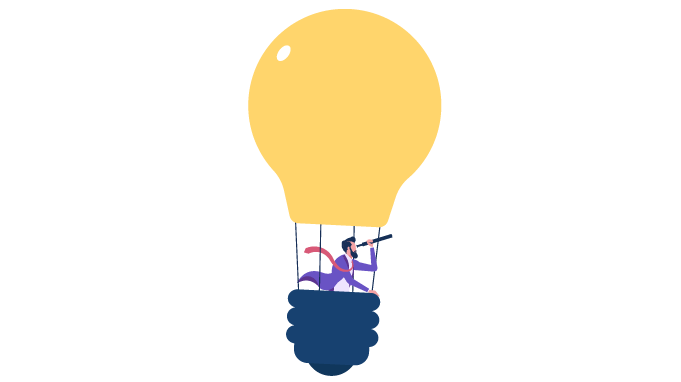
If you are a small team, reward segmentation might be a great way to keep your employees happy. But it might not be a great solution for bigger teams.
Reward segmentation is a rigid process. If you are a large organization with many employees and spread across multiple demographics, here are a few issues you might face-
-
Employee segments are not cast in stone. Their needs may change depending on multiple factors resulting in a change in the segment. It is difficult to keep adapting to these changing employee needs and preferences.
-
It can become difficult to manage and administer. Thus, leading to confusion and frustration among HR leaders.
-
Offering differentiated rewards for different employees might seem unfair to some of your employees. It can create feelings of division and resentment among them. And lead to a lack of motivation and higher attrition rates.
-
Managing multiple reward systems for each group can become complex and time-consuming.
The solution is simple. Shift the onus to your people and embrace a cafeteria approach or a flexible reward system.
Create a reward system that will allow your employees to choose a reward they value the most. For instance, create a points-based reward system.
It will allow your people to accumulate points for different achievements and milestones. They can then redeem those points for a reward of their choice. It could be merchandise, an adventure trip, or even charitable donations.
Imagine this. You have rewarded your sales team with a weekend getaway to a luxury resort. However, one of the sales representatives is a single parent and can't attend the getaway due to the lack of childcare options. As a result, this employee may feel undervalued and not taken care of.
However, the results might look different if you offer them the flexibility to choose their rewards, such as allowing them to opt for cash or rewards points instead of a physical reward.
Another great example is offering gift cards. For instance, you could offer gift cards to specific retailers, online shopping platforms, restaurants, and others. Above all else, you can customize the gift cards based on their personal interest, age, or geographical location.
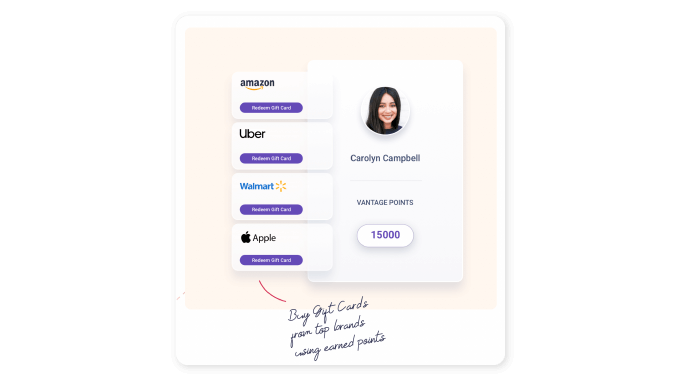
However, managing the gift card personalization, selection, and distribution process can feel overwhelming. An easy way to streamline this is to incorporate a digital employee rewards and benefits platform or tool.
Tools like Vantage Perks will streamline the entire process by offering a variety of gift card options for your teams in one centralized location.
Not sure how? Let me break it down for you.
Say you have employees based in Volgograd and Florida. It will help you offer gift cards ranging from winter sports stores and local coffee shops to local seafood restaurants, water parks, and others.
Want to know how else can Vantage Circle level up your reward and recognition program?
Why Is Segmentation Important?
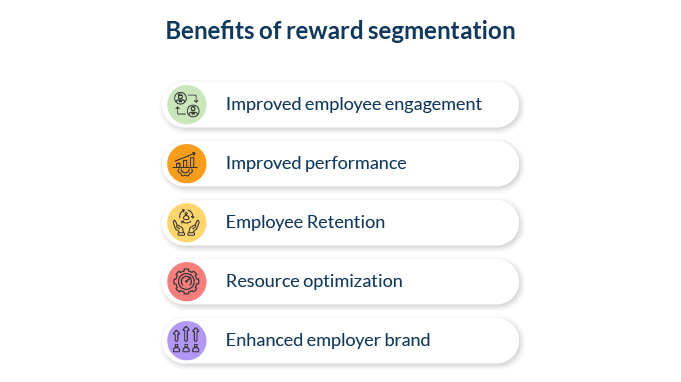
Here are a few benefits of reward segmentation-
1. Resource optimization:
Reward segmentation allows you to spend your limited fund and resources in a way that gives the most value. It helps you identify which rewards will have the most impact on your people. Thus you can manage and allocate your resources efficiently.
Ensure that the impactful employees are compensated well compared to those struggling to meet their objectives. But that should not mean you won't compensate the low-performing employees. Appreciate their little efforts and award them as well.
But do make sure that they understand their weaknesses so that they learn from them. As a result, your workforce will be more optimized in terms of productivity and will give their best while fulfilling their responsibilities.
2. Improved employee engagement:
Reward and recognition have been proven to influence employee engagement levels. Research says employee engagement is 14% higher in organizations where recognition occurs. Ensuring that employees receive rewards relevant to their specific roles and performance will only make this rate better for you.
3. Improved performance:
An effective recognition program can increase employee performance by 11.1%.
Tailored rewards can give a sense of psychological safety to your people. An employee segmentation example here could be a custom reward for the initiative takers. Or custom rewards for employees who have been part of the company's success for a few years.
When your people's individual needs and interests are being taken into account, they will feel like you've got their back. It's like saying that you care and you appreciate their efforts. It will boost their motivation and morale.
As a result, they will feel more invested in your organization's success. They will reciprocate your thoughtful initiative with better productivity and commitment. That can ultimately result in better team performance.
4. Employee Retention:
Research shows that 47% of employees want a spontaneous personalized reward. In contrast, employees who don't feel adequately recognized are 2x more likely to leave their position.
Reward segmentation can help you keep employees happy and loyal by offering them rewards that meet their expectations and deliver what matters most.
5. Enhanced employer brand:
Employee reward segmentation is a way to demonstrate that you value your people as individuals. It also depicts your commitment to maintaining employee happiness and satisfaction.
Thus by creating targeted reward programs, you are also building a positive employer brand. This, in turn, can help you attract top talent to the organization.
How To Segment Your Employees?
Age
A study done by Mercer's found that employees of different age groups value different elements of the company's reward package. While the older generations are more focused on retirement planning and health issuance. Millennials focus more on career advancement opportunities, such as training and development, mentoring, and others.
The study also found some overlaps. For instance, employees from all generations desire a predictable income, meaningful job roles, and others. Hence, it is critical to be mindful of the age while preparing a plan for reward segmentation.
Geographical location
Workforces living in different geographical locations have different values and priorities. Thus some forms of reward may have an insignificant impact on engagement and motivation in one country and become insignificant in another.
For instance, the value placed on work-life balance and job loyalty significantly varies in countries like Japan and Australia.
In Australia, employees put a greater emphasis on work-life balance and flexible work arrangements.
A study found that 51% of Gen-Z Australians look for better work/life balance in their job. In addition, almost a third of Australian employees would accept a pay cut if the employer offered a better work-life balance.
Japan's work culture depicts a different picture. In Japan, employees prioritize dedication to their work over personal time or work-life balance.
A survey shows that most Japanese employees feel guilty about taking paid time off. 53% of employees in Japan don't even know the number of their total annual leaves.
The differences will only increase if you have a team spread across the globe. This necessitates adopting a differentiated approach in your reward system to serve the varied needs.
In such a case, the best approach will be a custom reward program based on the geo-specific need of your people. Building upon the previous scenario, reward options for Australian employees can be-
- Additional WFH days
- Mental health support
- Workations
- Childcare facilities and others
In contrast, some great reward options for Japanese employees can be-
- Customized badges for the most committed employee of the month.
- Performance bonuses
- Special gift cards for initiative takes and others.
Performance-based segmentation

This type of segmentation is done based on the belief that employees who perform differently should be treated differently. Per this belief, you can segment your people into A, B, and C players.
The A players are the high performers who contribute most significantly to your organization's success. These are the employees who greatly impact product development, revenue, growth, sales, and other critical value drivers of your organization.
Rewarding these employees based on performance might set an example for B and C players. It might work as a source of motivation to work harder for rewards like their colleagues.
B players are the employees showing satisfactory performance consistently. And C players are the employees who are starting fresh and are still in the learning process.
For C players, the idea is to design a reward system that will support, engage, and motivate them to perform better in return for greater rewards.
Performance-based segmentation can help you understand what's or who's most important. But it doesn't allow you to understand what's important for your people.
Need-based segmentation
As the name suggests, it emphasizes categorizing employees based on their needs. In a study, the researcher found that each employee has one dominant need that works as a motivator and makes them stick to a job.
Based on Maslow's hierarchy of needs, the researcher further categorized employees into five different types:
- Survivors: Employees who work primarily for money
- Career chasers: Employees who seek stability in their jobs.
- Participators: Employees who work for social reasons or outside pressure.
- Hedonists: Workers who work to achieve more advanced goals.
- Innovators: Employees who enjoy their work as a way to express themselves.
Employee needs and their view of their role will also differ based on the stage of the employee lifecycle. It's another way to look at the needs-based segmentation of employees.
What Is The Process Of Reward Segmentation?
Not sure how to implement reward segmentation? Don’t worry we got you covered.
Here’s a step-by-step guide you can follow-
1. Conduct employee surveys and focus groups.
Surveys are a great tool to gauge deep into employee attitudes, preferences, and behaviors. The data collected from survey results will help you segment your employees into different sections.
However, if you are an organization with more than 8-10 employees, manually collecting and segmenting data can be daunting. In that case, use a survey tool to make the process easier and more efficient.
Make sure to choose a survey tool that helps you analyze the results in quantitative terms. Also, look for a tool that will allow you to analyze data category-wise, department-wise, and team-wise.
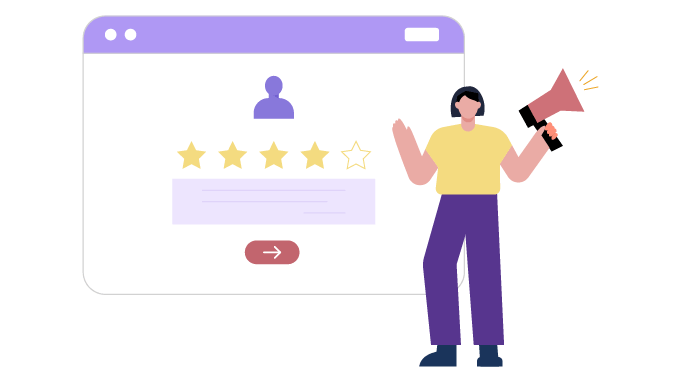
Take, for instance, Vantage Pulse, which offers robust visual reporting of the survey data in numerical form. Thus, it makes it easy to analyze and share survey findings with your teams in a clear and impactful way.
The next step will be to use this data to group employees based on common characteristics, their attitudes toward training and development needs, and more.
You can also organize focus groups to build upon the survey results and findings to gain deeper insight into employee perceptions and needs. These discussions will allow you to reach meaningful action-based results straight from employee ideas.
2. Create a reward segmentation plan.
Outline specific criteria for determining the reward segments. Identify the types of rewards and recognition that suit each segment best. For instance, for geo-based segmentation, you may consider the following:
- Cost of living
- Industry standards
- Local market conditions
Next, select the monetary and non-monetary rewards that align with the unique needs, characteristics, and challenges of each region.
Based on this data, prepare a reward segmentation plan.
The idea is to have a reward category for various performance-based segments. And if you want, you can keep adding more categories based on the changing employee/organizational dynamics. Just make sure that your plan is flexible enough to do that.
3. Collaborating with senior leaders

Communicate the results to your senior management and the key decision-makers.
This will ensure a shared understanding of the objectives and framework of the reward segmentation plan. Leadership buy-in is also important to ensure the reward segmentation plan is practical, feasible, and aligns with your overall business strategy.
In addition, it will give you valuable pointers and improvements from the management before rolling out the plan in action.
4. Run a pilot.
Design tailored reward packages for each employee segment and test them with a pilot project.
Running a pilot first can enable your organization to test the plan's effectiveness on a smaller scale before implementing it across the entire organization.
That being said, running a pilot at multiple levels among multiple groups of employees can be difficult. And the process doesn't end here. You will also have to make track, measure, analyze and find out its effectiveness.
An online platform or tool can be a great help here. Choose a platform that will ease the burden from your shoulder and simplify the whole process.
For instance, with a tool like Vantage Rewards, you can access real-time data on which vouchers or gift cards are most and least used. Or which employees are redeeming their points on what kind of items?
It will allow you to identify any issues, such as misaligned rewards and unintended consequences. And make necessary adjustments before rolling out the plan to everyone.
5. Refining the plan based on feedback
The next step is to gather feedback from the business units or employees who were part of the pilot project. Analyze the survey data to analyze what's working well and what needs to be worked on.
Use this data to refine the plan to ensure that it meets the needs and preferences of all your employees.
6. Scale up
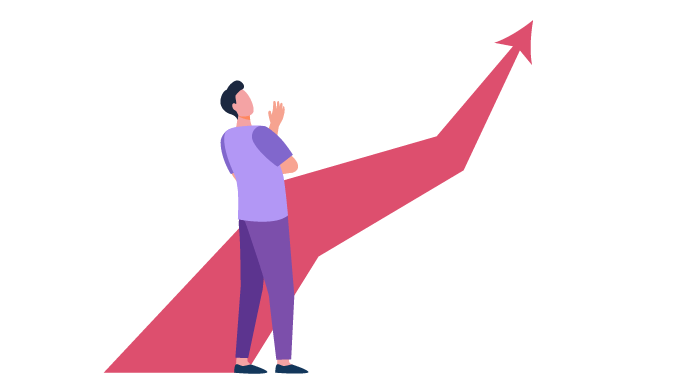
You are now ready to scale the plan across the organization. Also, make sure to keep evaluating, refining, and updating your employee reward segmentation plan so that it matches the changing employee needs and business goals.
Conclusion:
Well, the reward preferences of employees have changed. To meet these changing employee expectations, employee reward segmentation is a great initiative you can use.
But as I mentioned earlier, it's not everyone's cup of tea due to its complex and variable processes. In that case, add flexibility to your structures instead of creating different reward structures for each employee segment. The decision is up to you.
So, what's your take on it?
FAQ:
1. What is employee segmentation?
It is the process of dividing employees into different groups based on specific criteria. It could be their job role, performance, or demographics. It can help you better understand employees and create a tailored reward plan to meet their expectations.
What are the objectives of segmentation?
The objectives of reward segmentation are-f
To offer employees rewards that align with their diverse needs and preferences.
To ensure fairness and equity in reward distribution.
To recognize and reward employees for their contributions and performance.





















